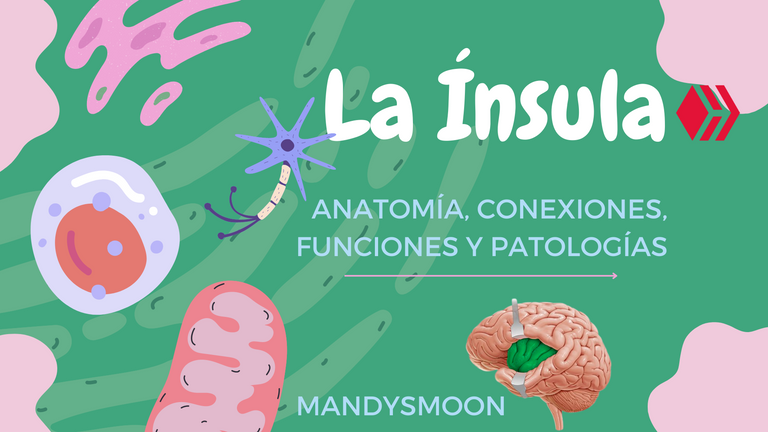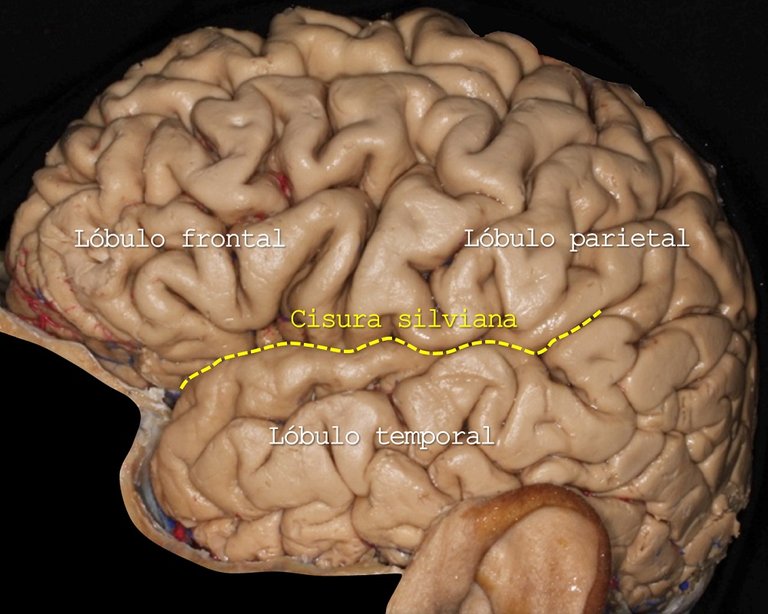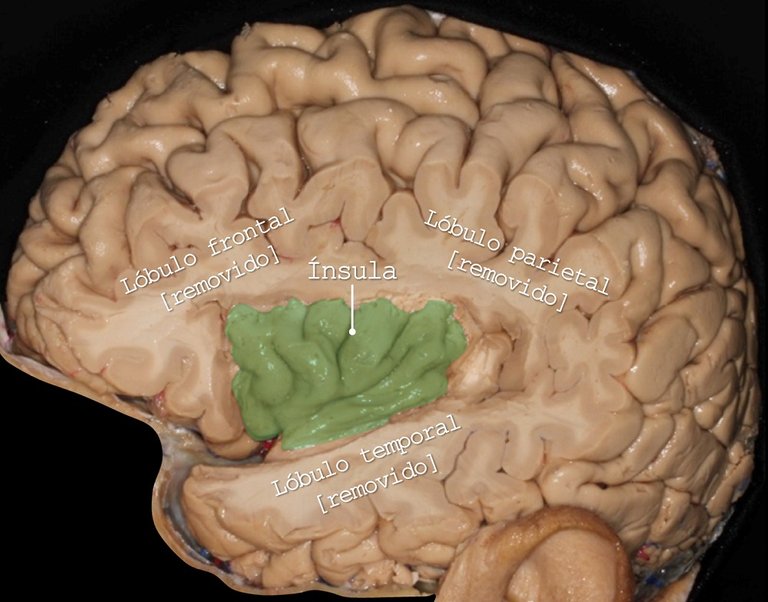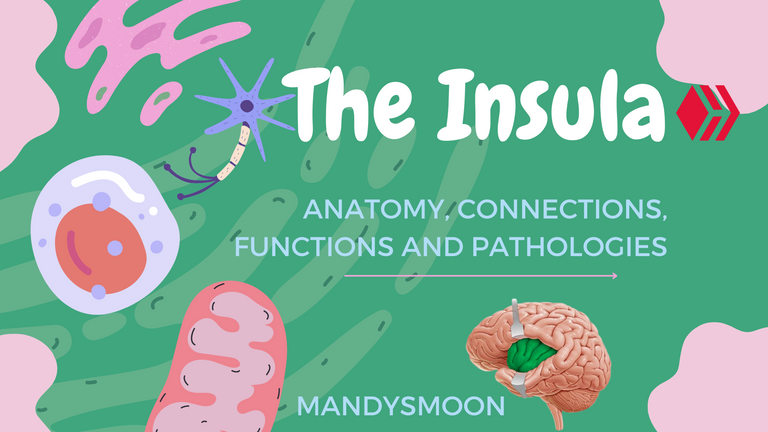[ESP] [ENG]🧠🔬 Una estructura oculta en el cerebro | A hidden structure in the brain🧠🔬
(Scroll down for english)
Soy Mandy y este es mi primer post en esta comunidad. Acompáñame a descubrir un poco sobre esta parte del maravilloso cerebro humano🧠✨

Esto quiere decir que para poder observarla debemos remover parte del lóbulo parietal, del frontal y del temporal para poder encontrar este otro pequeño lóbulo que si bien no es tomado como tal, si asemeja bastante en estructura y función.
Por eso Dennis Rains (2004) habla de su conexión con el sistema límbico que recibe tres fuentes de entrada cortical de información y también existen otras tres fuentes eferentes de conexión límbica hacia la corteza cerebral.
A través de estas conexiones la ínsula recibe aferencias de las vías del dolor, temperatura, visceral, vestibular y otras vías sensitivas. También de areas involucradas con la regulación cognitiva y emocional (Benarroch, 2019). A su vez se encarga del control cardíaco, el apetito y la excitación sexual (Mazzoglio y Nabar y Tornese, 2017).

Juega un rol fundamental en la percepción y modulación de la sensibilidad, sensorialidad e información vegetativa en donde se incluye el dolor. Está involucrada en el monitoreo de señales viscerales, además se le denomina "centro de alarma interno" porque participa en la detección e interpretación interoceptiva. Es el control y regulación de nuestros órganos.
Por otra parte, la porción anterior se considera parte del "cerebro social", pues participa en la respuesta de cooperación interpersonal que se origina durante el intercambio social. También se incluye dentro del circuito involucrado en el procesamiento afectivo, específicamente vinculado a la ansiedad (Mazzoglio y Nabar y Tornese, 2017).
Trastornos del Estado del Ánimo (Trastorno Bipolar y Trastornos Depresivos): Se ha detectado que la amígdala, el hipocampo y la corteza prefrontal están involucradas a la depresión porque existen alteraciones en el nivel del flujo sanguíneo en diferentes áreas cerebrales, destacando el sistema límbico. Por otro lado, en el trastorno bipolar se presenta alteraciones del volumen de los ganglios basales, la corteza prefrontal dorsolateral, el hipocampo, tálamo, y la amígdala, esta última presentando mayor volumen (Ledo-Varela et al., 2007)
Trastornos de Ansiedad: La fisiología de la respuesta ansiosa se produce de la siguiente manera: la información recogida por los sentidos viaja a través de sus vías nerviosas específicas hasta el tálamo, región encargada del procesamiento sensorial, luego se dirige a su región correspondiente de la corteza cerebral donde son recogidos los datos, y se decide activar la respuesta al miedo. Posteriormente es la amígdala la encargada de notificar la urgencia y crear un estado de alerta en las demás estructuras del cerebro. En la producción y modulación de la ansiedad también participan el septo lateral, el hipocampo, parte del hipotálamo (involucrado en la secreción de cortisol, hormona del estrés) y el locus cerúleo, que une la médula espinal con las áreas más desarrolladas del cerebro (Pérez, 2003)
Cuando ocurre una lesión o alteración en cualquier área de este proceso de activación de la respuesta ansiosa se comienza a manifestar los trastornos de ansiedad, por esto se recurre a la administración de fármacos en el tratamiento para mejorar dicho sistema (Montero y Barrantes, 2003).
 |  |
|---|
Trastornos del Espectro Autista (TEA): Diversos estudios han encontrado una alteración neurobiológica en el complejo amigdalino, como es el caso del estudio de Palmen et al. (2004) donde se obtuvieron resultados que comprobaban un incremento de la densidad de las células pero también una reducción de su tamaño en el hipocampo, subiculum y amígdala, pudiendo ocasionar déficits sociales y emocionales en individuos con autismo.
En los pacientes infantiles hay un mayor número de neuronas en las capas profundas de su corteza cerebral, indicando que no realizan una adecuada migración hacia las demás capas cerebrales. Esto influye en los circuitos del sistema límbico, dificultando el procesamiento emocional, como también en los circuitos del cerebelo (Casanova et al., 2013; Zhao et al., 2016)
Enfermedad de Alzheimer: Esta alteración neurodegenerativa presenta cambios microscópicos en el tejido cerebral, además de la pérdida progresiva de acetilcolina, sustancia química relevante para el funcionamiento cerebro.
La enfermedad ocasiona la muerte de las neuronas teniendo como consecuencia el deterioro de la memoria y habilidades del pensamiento, limitando al individuo a realizar solo tareas simples de la vida.
La atrofia cerebral que manifiestan los pacientes con Alzheimer afecta el área del hipocampo y la amígdala, luego a los lóbulos parietales y frontales y después a todo el cerebro. El progreso de la enfermedad por otras áreas del cerebro ocasiona la aparición de diversos síntomas conductuales, cognitivos y también psicológicos como apatía, anhedonia, irritabilidad, entre otros.
Trastorno del síndrome de KluverBucy: Este es un trastorno de la conducta y se origina debido a la destrucción uni o bilateral del complejo amigdalino, causando así hipersexualidad y el deseo excesivo de exploración oral y táctil, bulimia, trastornos de la memoria, emociones planas, astereognosia y prosopagnosia. Este síndrome puede aparecer cuando ocurren los siguientes trastornos: Traumatismo cráneo-encefálico, Accidente cerebrovascular, Encefalitis herpética, Epilepsia temporal, Demencias, Meningitis (Vallejos, 2020).
Amnesia Anterógrada: Esta patología se origina por una lesión en el hipocampo pero cuando es una amnesia anterógrada más profunda la lesión se dio en el tálamo anterior, y sucede que la información nueva no es consolidada en la memoria a largo plazo, simplemente no es recordada por la persona después de un determinado tiempo. Los acontecimientos antes de la lesión si son recordados, pero lo que suceda luego de esta no (Vallejos, 2020).
Amnesia Retrógrada: es producida por una lesión en el hipocampo y otras estructuras del lóbulo temporal, esta lesión puede ser causada por un traumatismo craneoencefálico, consumo de alcohol o drogas y por falta de vitamina B1, las consecuencias es que la persona afectada tiene perdida de los recuerdos sucedidos ante la situación que causo la lesión. Las memorias implicadas son: la memoria declarativa, la memoria semántica, memoria episódica y la memoria autobiográfica (Vallejos, 2020).
Trastorno por déficit de atención e hiperactividad (TDAH): surge debido a un agrandamiento en la zona del hipocampo y las amígdalas, causando sobrexcitación en las neuronas y esto origina una conducta de hiperactividad, impulsividad y falta de atención en los niños. Las conductas relacionadas a este trastorno se pueden observar a partir de los 3 años de edad y antes de los 12 años y es más común en hombres que en mujeres (Vallejos, 2020).
Esquizofrenia: Este trastorno se produce por la disminución del tamaño del complejo amigdalino, en hombres de manera bilateral y en mujeres solo del lado derecho, esto causando alteraciones del pensamiento, la percepción de la realidad y el comportamiento en las personas que lo padecen, pueden llegar a sufrir alucinaciones, psicosis y problemas a nivel social y laboral (Ledo-Varela, et, al, 2007).

Espero que este post resulte de su interés y les permita aprender un poco más sobre nuestro cerebro y sus maravillas.
Debo agradecer a estas preciosas personas @kiutvariedades @eldiariodelys y @omarqm por ayudar a recopilar todas esta información. Los quiero💕.
Instagram:
@mandismoon
Twitter:
@mandysmoon98

I'm Mandy and this is my first post in this community. Join me to discover a little about this part of the wonderful human brain🧠✨

This means that in order to observe it we must remove part of the parietal, frontal, and temporal lobe in order to find this other small lobe that, although it is not taken as such, is quite similar in structure and function.
That is why Dennis Rains (2004) talks about its connection with the limbic system, which receives three sources of cortical input of information and there are also three other efferent sources of limbic connection to the cerebral cortex.
Through these connections, the insula receives afferents from the pain, temperature, visceral control, vestibular control, and other sensory pathways. Also from areas involved with cognitive and emotional regulation (Benarroch, 2019). In turn, it is responsible for cardiac control, appetite and sexual arousal (Mazzoglio and Nabar and Tornese, 2017).

It plays a fundamental role in the perception and modulation of sensitivity, sensoriality and vegetative information where pain is included. It is involved in monitoring visceral signals, it is also called "internal alarm center" because it participates in interoceptive detection and interpretation. It is the control and regulation of our organs.
On the other hand, the anterior portion is considered part of the "social brain", since it participates in the interpersonal cooperation response that originates during social exchange. It is also included within the circuit involved in affective processing, specifically linked to anxiety (Mazzoglio & Nabar & Tornese, 2017).
Mood Disorders (Bipolar Disorder and Depressive Disorders): It has been detected that the amygdala, the hippocampus and the prefrontal cortex are involved in depression because there are alterations in the level of blood flow in different areas cerebral, emphasizing the limbic system. On the other hand, in bipolar disorder there are alterations in the volume of the basal ganglia, the dorsolateral prefrontal cortex, the hippocampus, thalamus, and the amygdala, the latter presenting greater volume (Ledo-Varela et al., 2007).
Anxiety Disorders: The physiology of the anxious response occurs as follows: the information collected by the senses travels through their specific nerve pathways to the thalamus, the region in charge of sensory processing, then is it goes to its corresponding region of the cerebral cortex where the data is collected, and it is decided to activate the response to fear. Subsequently, the amygdala is in charge of notifying the urgency and creating a state of alert in the other structures of the brain. The lateral septum, the hippocampus, part of the hypothalamus (involved in the secretion of cortisol, a stress hormone) and the locus ceruleus, which connects the spinal cord with the most developed areas of the brain (Perez, 2003)
When an injury or alteration occurs in any area of this process of activation of the anxious response, anxiety disorders begin to manifest, for this reason the administration of drugs is used in the treatment to improve said system (Montero and Barrantes, 2003).
 |  |
|---|
Autism Spectrum Disorders (ASD): Several studies have found a neurobiological alteration in the amygdala complex, as is the case of the study by Palmen et al. (2004) where results were obtained proving an increase in cell density but also a reduction in their size in the hippocampus, subiculum and amygdala, which can cause social and emotional deficits in individuals with autism.
In child patients there is a greater number of neurons in the deep layers of their cerebral cortex, indicating that they do not carry out an adequate migration towards the other cerebral layers. This influences the circuits of the limbic system, making emotional processing difficult, as well as the circuits of the cerebellum (Casanova et al., 2013; Zhao et al., 2016).
Alzheimer's disease: This neurodegenerative disorder presents microscopic changes in brain tissue, in addition to the progressive loss of acetylcholine, a chemical substance relevant to brain function.
The disease causes the death of neurons, resulting in the deterioration of memory and thinking skills, limiting the individual to perform only simple tasks of life.
The brain atrophy manifested by Alzheimer's patients affects the hippocampal and amygdala area, then the parietal and frontal lobes, and then the entire brain. The progress of the disease through other areas of the brain causes the appearance of various behavioral, cognitive and also psychological symptoms such as apathy, anhedonia, irritability, among others.
Kluver-Bucy Syndrome Disorder: This is a conduct disorder and arises from unilateral or bilateral destruction of the amygdaloid complex, thus causing hypersexuality and excessive desire for oral and tactile exploration, bulimia, disorders of memory, flat emotions, astereognosia and prosopagnosia. This syndrome can appear when the following disorders occur: head trauma, cerebrovascular accident, herpetic encephalitis, temporary epilepsy, dementia, meningitis (Vallejos, 2020).
Anterograde amnesia: This pathology is caused by a lesion in the hippocampus, but when it is a more profound anterograde amnesia, the lesion occurred in the anterior thalamus, and new information is not consolidated in memory after long term, it is simply not remembered by the person after a certain time. The events before the injury are remembered, but what happens after it is not (Vallejos, 2020).
Retrograde amnesia: it is produced by a lesion in the hippocampus and other structures of the temporal lobe. This lesion can be caused by a head injury, alcohol or drug use and a lack of vitamin B1, the consequences are that the affected person has lost the memories that happened before the situation that caused the injury. The memories involved are: declarative memory, semantic memory, episodic memory and autobiographical memory (Vallejos, 2020).
Attention deficit hyperactivity disorder (ADHD): arises due to an enlargement in the area of the hippocampus and tonsils, causing overexcitation in the neurons and this causes hyperactivity, impulsivity and inattention behavior In the kids. Behaviors related to this disorder can be observed from 3 years of age and before 12 years of age and it is more common in men than in women (Vallejos, 2020).
Schizophrenia: This disorder is caused by a decrease in the size of the amygdala complex, bilaterally in men and only on the right side in women, causing alterations in thought, perception of reality and behavior in People who suffer from it can suffer hallucinations, psychosis and social and work problems (Ledo-Varela, et al, 2007).

I hope this post is of interest to you and allows you to learn a little more about our brain and its wonders.
I must thank these precious people @kiutvariedades @eldiariodelys and @omarqm for helping to compile all this information. I love you guys💕.
Instagram:
@mandismoon
Twitter:
@mandysmoon98

Benarroch, E. E. (2019). Corteza insular. Complejidad funcional y correlaciones clínicas. Neurology, 93, 932-938. doi: 10.1212/WNL.0000000000008525
Bonilla, B., Castro, C., Rodríguez, R., Bujan, B., Melczer, M., & Gómez, G. (2014,). Lóbulo De La Insula: Pautas Anatomoquirúrgicas Para Su Manejo. Revista Argentina de Anatomía, 5(3), 99 - 103. https://www.revista-anatomia.com.ar/archivos-parciales/2014-3-revista-argentina-de-anatomia-online.
Casanova, M., El-Baz, A., Kamat, S., Dombroski, B., Khalifa, F., Elnakib, A.,
Soliman, A., Allison-McNutt, A., & Switala, A. (2013). Focal cortical dysplasias in autism spectrum disorders. Acta Neuropathologica Communications Volume, 1(67). https://actaneurocomms.biomedcentral.com/articles/10.1186/2051-5960-1-67#citeas
Dennis Rains, G. (2004). Principios de la neuropsicología humana. México: Editorial McGraw Hill.
Ledo-Varela, M. T., Giménez-Amaya, J. M., & Llamas, A. (2007). El complejo amigdalino humano y su implicación en los trastornos psiquiátricos. Anales Del Sistema Sanitario de Navarra, 30(1), 61-74. http://scielo.isciii.es/scielo.php?script=sci_arttext&pid=S1137-66272007000100007&lng=es&tlng=es
Mazzoglio y Nabar, M. J. & Tornese, E. B. (2017). Hallazgos Morfométricos y Funcionales Acerca de la Ínsula en Población VIH+ con Apatía. Int. J. Morphol, 35, (1), 273-286.
Montero, A. P., & Barrantes, F. (2003). Los trastornos afectivos y los de ansiedad. https://www.binasss.sa.cr/opac-ms/media/digitales/Los%20trastornos%20afectivos%20y%20los%20de%20ansiedad.pdf
Palmen, S., van Engeland, H., Hof, P., & Schmitz, C. (2004). Neuropathological findings in autism. Brain, 127(12), 2572-2583. https://doi.org/10.1093/brain/awh287
Pérez, M. (2003). Dónde y cómo se produce la ansiedad: sus bases biológicas. Ciencia. https://www.revistaciencia.amc.edu.mx/images/revista/54_2/como_produce_ansiedad.pdf
Vallejos, S. (2020). Sistema Límbico. Componentes, funciones y Patologías. [Archivo PDF]. Disponible: https://www.studocu.com/latam/document/universidad-nacional-de-caaguazu/anatomia-descriptiva/sistema-limbico-componentes-funciones-patologias/11493107
Zhao, G., Walsh, K., Long, J., Gui, W., & Desinova, K. (2016). Reduced structural complexity of the right cerebellar cortex in male children with autism spectrum disorder. PLoS ONE, 13(7). https://doi.org/10.1371/journal.pone
https://twitter.com/1623765819627806727/status/1645402714904330244
The rewards earned on this comment will go directly to the people sharing the post on Twitter as long as they are registered with @poshtoken. Sign up at https://hiveposh.com.
https://twitter.com/mandysmoon98/status/1645402714904330244?s=20
el cuerpo humano es tan perfecto, que hasta el órgano mas pequeño tiene grandes funciones, gracias por la información
Estoy muy de acuerdo contigo. ¡Gracias por comentar!✨